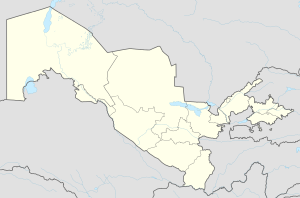Samarkand
|
Samarkand Uzbek: Samarqand, Самарқанд |
||
|---|---|---|
 |
||
|
||
| Location in Uzbekistan | ||
| Coordinates: 39°42′N 66°59′E / 39.700°N 66.983°ECoordinates: 39°42′N 66°59′E / 39.700°N 66.983°E | ||
| Country |
|
|
| Region | Samarqand Region | |
| Settled | 5th century BC | |
| Government | ||
| • Type | City Administration | |
| • Hakim (Mayor) | Akbar Shukurov | |
| Area | ||
| • Total | 108 km2 (42 sq mi) | |
| Elevation | 702 m (2,303 ft) | |
| Population (2015) | ||
| • Total | 504,423 | |
| Time zone | (UTC+5) | |
| Website | https://samarkand.blog/ | |
| Samarkand – Crossroads of Culture | |
|---|---|
| Name as inscribed on the World Heritage List | |

|
|
| Location | Uzbekistan |
| Type | Cultural |
| Criteria | i, ii, iv |
| Reference | 603 |
| UNESCO region | Asia-Pacific |
| Inscription history | |
| Inscription | 2001 (25th Session) |
Samarkand (from Sogdian: "Stone Fort" or "Rock Town"; Uzbek: Samarqand; Persian: سمرقند; Cyrillic/Russian: Самарканд), alternatively Samarqand or Samarcand, is a city in modern-day Uzbekistan and is one of the oldest inhabited cities in Central Asia. There is evidence of human activity in the area of the city from the late Paleolithic era, though there is no direct evidence of when exactly Samarkand proper was founded; some theories are that it was founded between the 8th and 7th centuries BC. Prospering from its location on the Silk Road between China and the Mediterranean, at times Samarkand was one of the greatest cities of Central Asia.
By the time of the Achaemenid Empire of Persia, it was the capital of the Sogdian satrapy. The city was taken by Alexander the Great in 329 BC, when it was known by its Greek name of Marakanda. The city was ruled by a succession of Iranian, Persian, and Turkic peoples until the Mongols under Genghis Khan conquered Samarkand in 1220. Today, Samarkand is the capital of Samarqand Region, and Uzbekistan's second largest city.
The city is noted for being an Islamic centre for scholarly study. In the 14th century it became the capital of the empire of Timur (Tamerlane) and is the site of his mausoleum (the Gur-e Amir). The Bibi-Khanym Mosque (a modern replica) remains one of the city's most notable landmarks. The Registan was the ancient center of the city. The city has carefully preserved the traditions of ancient crafts: embroidery, gold embroidery, silk weaving, engraving on copper, ceramics, carving, and painting on wood. In 2001, UNESCO added the city to its World Heritage List as Samarkand – Crossroads of Cultures.
...
Wikipedia


